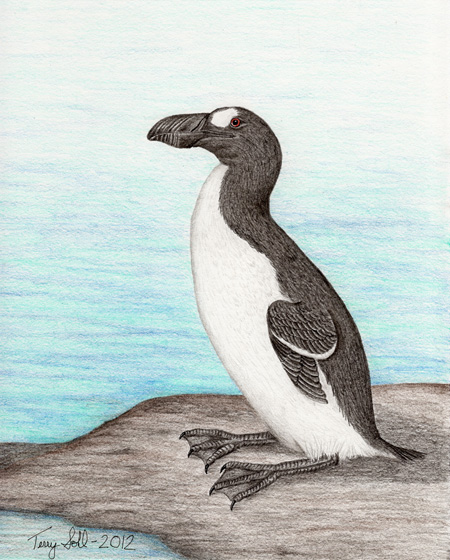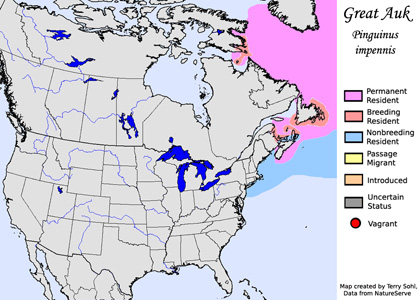Great Auk
Pinguinus impennis
| Length: 30-34 inches | Weight: 9-11 pounds | Seasonality: Non-resident in South Dakota |
| ID Keys: Very large alcid, large thick bill, black upperparts, white underparts, white spot in front of eye | ||
 The
Great Auk is a large, extinct, penguin-like bird that was once found in the
north Atlantic in both North America, and Europe. They were the
largest of the "Alcids", birds which include the more familiar puffins of
the Americas. They were the only member of the genus Pinguinus, and
were also the only flightless alcid. The species was evidently once
relatively common across parts of the North Atlantic, although nesting
colonies were relatively uncommon, given the specie's specific habitat
requirements for nesting. The species was hunted for food and for
their downy feathers for many centuries, and breeding colonies in the
European side of the Atlantic were largely gone by the 1600s.
Persecution of the species was also rampant in North America after European
colonization. The last known breeding attempts were in 1840s, and the
last known sighting of the bird was in 1852.
The
Great Auk is a large, extinct, penguin-like bird that was once found in the
north Atlantic in both North America, and Europe. They were the
largest of the "Alcids", birds which include the more familiar puffins of
the Americas. They were the only member of the genus Pinguinus, and
were also the only flightless alcid. The species was evidently once
relatively common across parts of the North Atlantic, although nesting
colonies were relatively uncommon, given the specie's specific habitat
requirements for nesting. The species was hunted for food and for
their downy feathers for many centuries, and breeding colonies in the
European side of the Atlantic were largely gone by the 1600s.
Persecution of the species was also rampant in North America after European
colonization. The last known breeding attempts were in 1840s, and the
last known sighting of the bird was in 1852.
Habitat: During the nesting season, Great Auks required isolated, rocky islands with sloping shorelines for easy access, and plentiful nearby food supplies. Breeding colonies may never have numbered more than a couple of dozen. When not breeding, they roamed widely in the North Atlantic, often far from shore.
Diet: Fed almost exclusively on fish.
Behavior: Foraged by diving for fish, with the capability to dive much deeper than other alcids. Foraging was often in flocks, with some evidence that the species cooperatively foraged. Great Auks were pelagic at nearly all seasons, never coming ashore except during the nesting season.
Nesting: The Great Auk nested colonial, with large nesting colonies found in only a few well-established and suitable locations. Pairs tended to one egg, laid on a shallow depression on the ground. Both parents would incubate the egg, and both would help to raise the young. Great Auk pairs may have mated for life.
Song: Breeding colonies were evidently noisy places, with Great Auks making a variety of croaking sounds.
Migration: Breeding occurred in only a few known rocky islands. Non-breeding birds could be found in many locations throughout the North Atlantic. After breeding, breeding pairs and their young dispersed at sea, and in winter, there was some movement of populations to the south. In North America, wintering birds could be found along coastlines in New England, although rarely there were sightings further south.
Similar Species: Unique. The Great Auk was not only much larger than other alcids, but they were the only flightless alcid. The Razorbill is generally considered the closest living relative of the Great Auk.
Conservation Status: Extinct, with the last of the species seen in the 1840s or 1850s.
Further Information: 1) Audubon - Great Auk
2) Natural History Museum - Great Auk
3) PolarLife.ca - Great Auk
Image Information: Colored pencil drawing by Terry Sohl - January 2012
| Click below for a higher-resolution map |
 |
| South Dakota Status: Never a resident in South Dakota. Now extinct. |
Additional Great Auk Images
Click for a higher-resolution version of these photos

